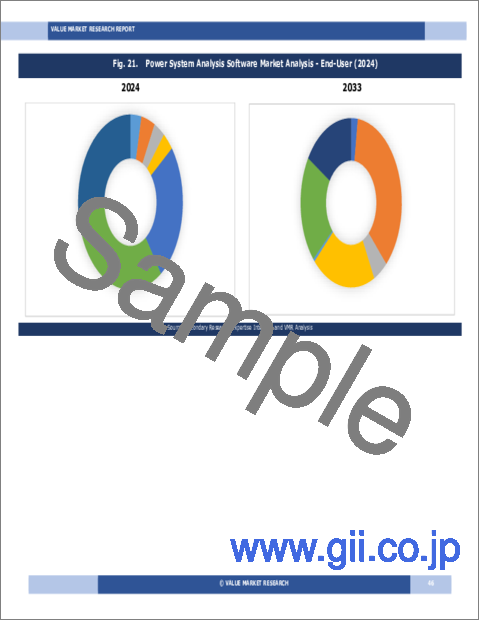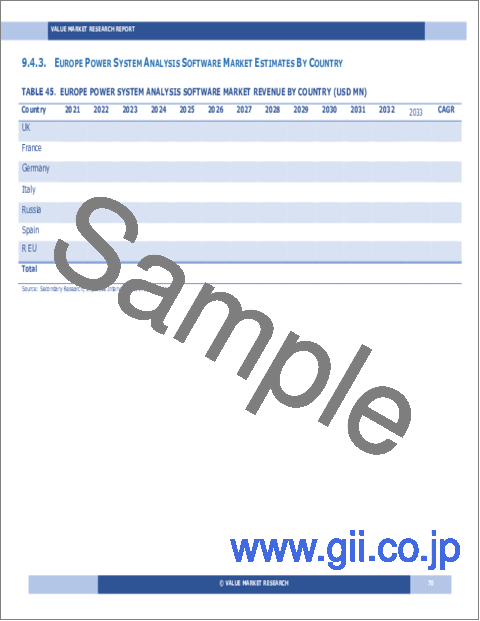|
|
市場調査レポート
商品コード
1676139
電力系統解析ソフトウェアの世界市場調査レポート:産業分析、規模、シェア、成長、動向、予測(2025年~2033年)Global Power System Analysis Software Market Research Report- Industry Analysis, Size, Share, Growth, Trends and Forecast 2025 to 2033 |
||||||
カスタマイズ可能
|
|||||||
| 電力系統解析ソフトウェアの世界市場調査レポート:産業分析、規模、シェア、成長、動向、予測(2025年~2033年) |
|
出版日: 2025年03月01日
発行: Value Market Research
ページ情報: 英文 136 Pages
納期: 即日から翌営業日
|
全表示
- 概要
- 図表
- 目次
電力系統解析ソフトウェアの世界市場規模は、2024年の62億4,000万米ドルから2033年には126億2,000万米ドルに成長し、2026年から2033年の予測期間中に8.13%の堅調な年間平均成長率(CAGR)を示すと予測されます。
電力系統解析ソフトウェア市場は、効率的で信頼性の高い電力管理ソリューションへの需要が高まるにつれ、大きな成長を遂げています。電力系統解析ソフトウェアは、電力会社やエネルギー会社が電力系統をモデル化、分析、最適化し、エネルギー配給の安定性と信頼性を確保するために不可欠です。再生可能エネルギーの統合、送電網の近代化、規制遵守への関心の高まりが、電力系統解析ツールへの投資を促進し、市場拡大をさらに後押ししています。さらに、リアルタイムのモニタリングと予測分析に対するニーズの高まりが、先進的なソフトウェアソリューションの採用に寄与しています。
技術の進歩は、電力系統解析ソフトウェア市場の将来を形作る上で重要な役割を果たしています。シミュレーションアルゴリズム、データ解析、クラウドコンピューティングの革新は、電力系統解析ツールの機能を強化し、より正確なモデリングと予測を可能にしています。さらに、IoTデバイスとスマートグリッド技術の統合により、データ収集と分析が改善され、より良い意思決定と運用効率が可能になりつつあります。メーカー各社が技術革新と新ソリューションの開発を続けるなか、電力系統解析ソフトウェア市場は、公益事業、産業施設、再生可能エネルギープロジェクトなど、さまざまな分野で導入が進むとみられます。
さらに、持続可能性とエネルギー効率を重視する傾向が強まっていることも、電力系統解析ソフトウェア市場の成長軌道に影響を与えています。企業が二酸化炭素排出量を削減し、エネルギー使用量を最適化しようとしているため、エネルギー管理と持続可能性への取り組みをサポートするソフトウェアに対する需要が高まっています。この動向は、持続可能性の目標に沿った統合ソリューションを開発するために、ソフトウェアプロバイダー、エネルギー企業、規制機関の間の協力を促進しています。市場が進化を続ける中、テクノロジー、持続可能性、規制遵守の統合が成功の重要な促進要因となると思われます。
当社のレポートは、様々な業界や市場に関する包括的かつ実用的な洞察をお客様に提供するために、細心の注意を払って作成されています。各レポートは、市場情勢を完全に理解するために、いくつかの重要な要素を含んでいます:
市場概要:定義、分類、業界の現状など、市場に関する詳細なイントロダクション。
市場促進要因:市場成長に影響を与える主な促進要因・抑制要因・市場促進要因・課題を詳細に分析します。このセクションでは、技術の進歩、規制の変更、新たな動向などの要因を検証します。
セグメンテーション分析:製品タイプ、用途、エンドユーザー、地域などの基準に基づき、市場を明確なセグメントに内訳。この分析により、各セグメントの業績と将来性を明らかにします。
競合情勢:市場シェア、製品ポートフォリオ、戦略的イニシアティブ、財務実績など、主要市場企業の包括的評価。主要企業が採用する競合力学と主要戦略に関する考察を提供します。
市場予測:過去のデータと現在の市場状況に基づき、一定期間における市場規模と成長動向を予測します。これには、定量的分析と将来の市場軌跡を示すグラフ表示が含まれます。
地域分析:地域ごとの市場パフォーマンスを評価し、主要市場や地域動向を明らかにします。地域の市場力学とビジネスチャンスを理解するのに役立ちます。
新たな動向と機会:現在の市場動向と新たな市場動向、技術革新、潜在的な投資対象分野を特定します。将来の市場開拓と成長見通しに関する洞察を提供します。
目次
第1章 序文
第2章 エグゼクティブサマリー
- 市場のハイライト
- 世界市場スナップショット
第3章 電力系統解析ソフトウェア産業分析
- イントロダクション:市場力学
- 市場促進要因
- 市場抑制要因
- 市場機会
- 業界動向
- ポーターのファイブフォース分析
- 市場の魅力分析
第4章 バリューチェーン分析
- バリューチェーン分析
- 原材料分析
- 原材料リスト
- 原材料メーカーリスト
- 主要原材料の価格動向
- 潜在的バイヤーリスト
- マーケティングチャネル
- ダイレクトマーケティング
- インダイレクトマーケティング
- マーケティングチャネル発展動向
第5章 電力系統解析ソフトウェアの世界市場分析:モジュール別
- 概要:モジュール別
- 実績データと予測データ分析:モジュール別
- 負荷フロー解析
- 短絡解析
- アークフラッシュ解析
- 機器連携解析
- その他
第6章 電力系統解析ソフトウェアの世界市場分析:展開モード別
- 概要:展開モード別
- 実績データと予測データ分析:展開モード別
- オンプレミス
- クラウドベース
第7章 電力系統解析ソフトウェアの世界市場分析:エンドユーザー別
- 概要:エンドユーザー別
- 実績データと予測データ分析:エンドユーザー別
- 公益事業
- 産業用
- 商業用
- その他
第8章 電力系統解析ソフトウェアの世界市場分析:用途別
- 概要:用途別
- 実績データと予測データ分析: 用途別
- 送電と配電
- 発電
- その他
第9章 電力系統解析ソフトウェアの世界市場分析:地域別
- 地域別の展望
- イントロダクション
- 北米の売上分析
- 概要、実績と予測
- 北米:セグメント別
- 北米:国別
- 米国
- カナダ
- メキシコ
- 欧州の売上分析
- 概要、実績と予測
- 欧州:セグメント別
- 欧州:国別
- 英国
- フランス
- ドイツ
- イタリア
- ロシア
- その他欧州
- アジア太平洋の売上分析
- 概要、実績と予測
- アジア太平洋:セグメント別
- アジア太平洋:国別
- 中国
- インド
- 日本
- 韓国
- オーストラリア
- 東南アジア
- その他アジア太平洋
- ラテンアメリカの売上分析
- 概要、実績と予測
- ラテンアメリカ:セグメント別
- ラテンアメリカ:国別
- ブラジル
- アルゼンチン
- ペルー
- チリ
- その他ラテンアメリカ
- 中東・アフリカの売上分析
- 概要、実績と予測
- 中東・アフリカ:セグメント別
- 中東・アフリカ:国別
- サウジアラビア
- アラブ首長国連邦
- イスラエル
- 南アフリカ
- その他中東・アフリカ
第10章 電力系統解析ソフトウェア企業の競合情勢
- 電力系統解析ソフトウェア市場の競合
- 提携・協力・合意
- 合併・買収
- 新製品の発売
- その他の開発
第11章 企業プロファイル
- 上位企業の市場シェア分析
- 市場集中度
- Schneider Electric
- Siemens AG
- General Electric(GE)Company
- ABB Ltd.
- Eaton Corporation
- ETAP(Operation Technology Inc.)
- PSI Software AG
- PowerWorld Corporation
- DIgSILENT GmbH
- Energy Exemplar
- Neplan AG
- Open Systems International Inc.(OSI)
- Schweitzer Engineering Laboratories(SEL)
- MathWorks Inc.
- CYME International T&D
LIST OF TABLES
- Market Snapshot
- Drivers: Impact Analysis
- Restraints: Impact Analysis
- List of Raw Material
- List of Raw Material Manufactures
- Analysis By Module (USD MN)
- Load Flow Analysis Market Sales By Geography (USD MN)
- Short Circuit Analysis Market Sales By Geography (USD MN)
- Arc Flash Analysis Market Sales By Geography (USD MN)
- Device Coordination Analysis Market Sales By Geography (USD MN)
- Others Market Sales By Geography (USD MN)
- Analysis By Deployment Mode (USD MN)
- On-Premises Market Sales By Geography (USD MN)
- Cloud-Based Market Sales By Geography (USD MN)
- Analysis By End-User (USD MN)
- Utilities Market Sales By Geography (USD MN)
- Industrial Market Sales By Geography (USD MN)
- Commercial Market Sales By Geography (USD MN)
- Others Market Sales By Geography (USD MN)
- Analysis By Application (USD MN)
- Transmission and Distribution Market Sales By Geography (USD MN)
- Generation Market Sales By Geography (USD MN)
- Others Market Sales By Geography (USD MN)
- Global Power System Analysis Software Market Sales By Geography (USD MN)
- North America Market Analysis (USD MN)
- United States Market Analysis (USD MN)
- Canada Market Analysis (USD MN)
- Mexico Market Analysis (USD MN)
- Europe Market Analysis (USD MN)
- Europe Market Estimate By Country (USD MN)
- United Kingdom Market Analysis (USD MN)
- France Market Analysis (USD MN)
- Germany Market Analysis (USD MN)
- Italy Market Analysis (USD MN)
- Russia Market Analysis (USD MN)
- Spain Market Analysis (USD MN)
- Rest of Europe Market Analysis (USD MN)
- Asia Pacific Market Analysis (USD MN)
- China Market Analysis (USD MN)
- Japan Market Analysis (USD MN)
- India Market Analysis (USD MN)
- South Korea Market Analysis (USD MN)
- Australia Market Analysis (USD MN)
- South East Asia Market Analysis (USD MN)
- Rest of Asia Pacific Market Analysis (USD MN)
- Latin America Market Analysis (USD MN)
- Brazil Market Analysis (USD MN)
- Argentina Market Analysis (USD MN)
- Peru Market Analysis (USD MN)
- Chile Market Analysis (USD MN)
- Rest of Latin America Market Analysis (USD MN)
- Middle East & Africa Market Analysis (USD MN)
- Saudi Arabia Market Analysis (USD MN)
- UAE Market Analysis (USD MN)
- Israel Market Analysis (USD MN)
- South Africa Market Analysis (USD MN)
- Rest of Middle East and Africa Market Analysis (USD MN)
- Partnership/Collaboration/Agreement
- Mergers And Acquisition
LIST OF FIGURES
- Research Scope of Power System Analysis Software Report
- Market Research Process
- Market Research Methodology
- Global Power System Analysis Software Market Size, By Region (USD MN)
- Porters Five Forces Analysis
- Market Attractiveness Analysis By Module
- Market Attractiveness Analysis By Deployment Mode
- Market Attractiveness Analysis By End-User
- Market Attractiveness Analysis By Application
- Market Attractiveness Analysis By Region
- Value Chain Analysis
- Global Market Analysis By Module (USD MN)
- Load Flow Analysis Market Sales By Geography (USD MN)
- Short Circuit Analysis Market Sales By Geography (USD MN)
- Arc Flash Analysis Market Sales By Geography (USD MN)
- Device Coordination Analysis Market Sales By Geography (USD MN)
- Others Market Sales By Geography (USD MN)
- Global Market Analysis By Deployment Mode (USD MN)
- On-Premises Market Sales By Geography (USD MN)
- Cloud-Based Market Sales By Geography (USD MN)
- Global Market Analysis By End-User (USD MN)
- Utilities Market Sales By Geography (USD MN)
- Industrial Market Sales By Geography (USD MN)
- Commercial Market Sales By Geography (USD MN)
- Others Market Sales By Geography (USD MN)
- Global Market Analysis By Application (USD MN)
- Transmission and Distribution Market Sales By Geography (USD MN)
- Generation Market Sales By Geography (USD MN)
- Others Market Sales By Geography (USD MN)
- Global Market Sales (USD MN)
- North America Market Sales (USD MN)
- Europe Market Sales (USD MN)
- Asia Pacific Market Sales (USD MN)
- Latin America Market Sales (USD MN)
- Middle East & Africa Market Sales (USD MN)
- Recent Development in Industry
- Top Company Market Share Analysis
- Kindly note that the above listed are the basic tables and figures of the report and are not limited to the TOC.
Global Power System Analysis Software Market size is anticipated to grow from USD 6.24 Billion in 2024 to USD 12.62 Billion by 2033, showcasing a robust Compound Annual Growth Rate (CAGR) of 8.13% during the forecast period of 2026 to 2033.
The Power System Analysis Software Market is experiencing significant growth as the demand for efficient and reliable power management solutions increases. Power system analysis software is essential for utilities and energy companies to model, analyze, and optimize electrical power systems, ensuring stability and reliability in energy distribution. The rising focus on renewable energy integration, grid modernization, and regulatory compliance is driving investments in power system analysis tools, further propelling market expansion. Additionally, the growing need for real-time monitoring and predictive analytics is contributing to the adoption of advanced software solutions.
Technological advancements are playing a crucial role in shaping the future of the power system analysis software market. Innovations in simulation algorithms, data analytics, and cloud computing are enhancing the capabilities of power system analysis tools, enabling more accurate modeling and forecasting. Furthermore, the integration of IoT devices and smart grid technologies is improving data collection and analysis, allowing for better decision-making and operational efficiency. As manufacturers continue to innovate and develop new solutions, the power system analysis software market is likely to see increased adoption across various sectors, including utilities, industrial facilities, and renewable energy projects.
Moreover, the growing emphasis on sustainability and energy efficiency is influencing the power system analysis software market's growth trajectory. As organizations seek to reduce their carbon footprint and optimize energy usage, there is a rising demand for software that supports energy management and sustainability initiatives. This trend is driving collaboration between software providers, energy companies, and regulatory bodies to develop integrated solutions that align with sustainability goals. As the market continues to evolve, the integration of technology, sustainability, and regulatory compliance will be key drivers of success.
Our reports are meticulously crafted to provide clients with comprehensive and actionable insights into various industries and markets. Each report encompasses several critical components to ensure a thorough understanding of the market landscape:
Market Overview: A detailed introduction to the market, including definitions, classifications, and an overview of the industry's current state.
Market Dynamics: In-depth analysis of key drivers, restraints, opportunities, and challenges influencing market growth. This section examines factors such as technological advancements, regulatory changes, and emerging trends.
Segmentation Analysis: Breakdown of the market into distinct segments based on criteria like product type, application, end-user, and geography. This analysis highlights the performance and potential of each segment.
Competitive Landscape: Comprehensive assessment of major market players, including their market share, product portfolio, strategic initiatives, and financial performance. This section provides insights into the competitive dynamics and key strategies adopted by leading companies.
Market Forecast: Projections of market size and growth trends over a specified period, based on historical data and current market conditions. This includes quantitative analyses and graphical representations to illustrate future market trajectories.
Regional Analysis: Evaluation of market performance across different geographical regions, identifying key markets and regional trends. This helps in understanding regional market dynamics and opportunities.
Emerging Trends and Opportunities: Identification of current and emerging market trends, technological innovations, and potential areas for investment. This section offers insights into future market developments and growth prospects.
SEGMENTATION COVERED IN THE REPORT
By Module
- Load Flow Analysis
- Short Circuit Analysis
- Arc Flash Analysis
- Device Coordination Analysis
- Others
By Deployment Mode
- On-Premises
- Cloud-Based
By End-User
- Utilities
- Industrial
- Commercial
- Others
By Application
- Transmission and Distribution
- Generation
- Others
- COMPANIES PROFILED
- Schneider Electric
- Siemens AG
- General Electric (GE) Company
- ABB Ltd.
- Eaton Corporation
- ETAP (Operation Technology Inc.)
- PSI Software AG
- PowerWorld Corporation
- DIgSILENT GmbH
- Energy Exemplar
- Neplan AG
- Open Systems International Inc. (OSI)
- Schweitzer Engineering Laboratories (SEL)
- MathWorks Inc.
- CYME International T&D
- The above list can be customized.
TABLE OF CONTENTS
1. PREFACE
- 1.1. Report Description
- 1.1.1 Objective
- 1.1.2 Target Audience
- 1.1.3 Unique Selling Proposition (USP) & offerings
- 1.2. Research Scope
- 1.3. Research Methodology
- 1.3.1 Market Research Process
- 1.3.2 Market Research Methodology
2. EXECUTIVE SUMMARY
- 2.1. Highlights of Market
- 2.2. Global Market Snapshot
3. POWER SYSTEM ANALYSIS SOFTWARE INDUSTRY ANALYSIS
- 3.1. Introduction - Market Dynamics
- 3.2. Market Drivers
- 3.3. Market Restraints
- 3.4. Opportunities
- 3.5. Industry Trends
- 3.6. Porters Five Force Analysis
- 3.7. Market Attractiveness Analysis
- 3.7.1 Market Attractiveness Analysis By Module
- 3.7.2 Market Attractiveness Analysis By Deployment Mode
- 3.7.3 Market Attractiveness Analysis By End-User
- 3.7.4 Market Attractiveness Analysis By Application
- 3.7.5 Market Attractiveness Analysis By Region
4. VALUE CHAIN ANALYSIS
- 4.1. Value Chain Analysis
- 4.2. Raw Material Analysis
- 4.2.1 List of Raw Materials
- 4.2.2 Raw Material Manufactures List
- 4.2.3 Price Trend of Key Raw Materials
- 4.3. List of Potential Buyers
- 4.4. Marketing Channel
- 4.4.1 Direct Marketing
- 4.4.2 Indirect Marketing
- 4.4.3 Marketing Channel Development Trend
5. GLOBAL POWER SYSTEM ANALYSIS SOFTWARE MARKET ANALYSIS BY MODULE
- 5.1. Overview By Module
- 5.2. Historical and Forecast Data Analysis By Module
- 5.3. Load Flow Analysis Historic and Forecast Sales By Regions
- 5.4. Short Circuit Analysis Historic and Forecast Sales By Regions
- 5.5. Arc Flash Analysis Historic and Forecast Sales By Regions
- 5.6. Device Coordination Analysis Historic and Forecast Sales By Regions
- 5.7. Others Historic and Forecast Sales By Regions
6. GLOBAL POWER SYSTEM ANALYSIS SOFTWARE MARKET ANALYSIS BY DEPLOYMENT MODE
- 6.1. Overview By Deployment Mode
- 6.2. Historical and Forecast Data Analysis By Deployment Mode
- 6.3. On-Premises Historic and Forecast Sales By Regions
- 6.4. Cloud-Based Historic and Forecast Sales By Regions
7. GLOBAL POWER SYSTEM ANALYSIS SOFTWARE MARKET ANALYSIS BY END-USER
- 7.1. Overview By End-User
- 7.2. Historical and Forecast Data Analysis By End-User
- 7.3. Utilities Historic and Forecast Sales By Regions
- 7.4. Industrial Historic and Forecast Sales By Regions
- 7.5. Commercial Historic and Forecast Sales By Regions
- 7.6. Others Historic and Forecast Sales By Regions
8. GLOBAL POWER SYSTEM ANALYSIS SOFTWARE MARKET ANALYSIS BY APPLICATION
- 8.1. Overview By Application
- 8.2. Historical and Forecast Data Analysis By Application
- 8.3. Transmission and Distribution Historic and Forecast Sales By Regions
- 8.4. Generation Historic and Forecast Sales By Regions
- 8.5. Others Historic and Forecast Sales By Regions
9. GLOBAL POWER SYSTEM ANALYSIS SOFTWARE MARKET ANALYSIS BY GEOGRAPHY
- 9.1. Regional Outlook
- 9.2. Introduction
- 9.3. North America Sales Analysis
- 9.3.1 Overview, Historic and Forecast Data Sales Analysis
- 9.3.2 North America By Segment Sales Analysis
- 9.3.3 North America By Country Sales Analysis
- 9.3.4 United States Sales Analysis
- 9.3.5 Canada Sales Analysis
- 9.3.6 Mexico Sales Analysis
- 9.4. Europe Sales Analysis
- 9.4.1 Overview, Historic and Forecast Data Sales Analysis
- 9.4.2 Europe By Segment Sales Analysis
- 9.4.3 Europe By Country Sales Analysis
- 9.4.4 United Kingdom Sales Analysis
- 9.4.5 France Sales Analysis
- 9.4.6 Germany Sales Analysis
- 9.4.7 Italy Sales Analysis
- 9.4.8 Russia Sales Analysis
- 9.4.9 Rest Of Europe Sales Analysis
- 9.5. Asia Pacific Sales Analysis
- 9.5.1 Overview, Historic and Forecast Data Sales Analysis
- 9.5.2 Asia Pacific By Segment Sales Analysis
- 9.5.3 Asia Pacific By Country Sales Analysis
- 9.5.4 China Sales Analysis
- 9.5.5 India Sales Analysis
- 9.5.6 Japan Sales Analysis
- 9.5.7 South Korea Sales Analysis
- 9.5.8 Australia Sales Analysis
- 9.5.9 South East Asia Sales Analysis
- 9.5.10 Rest Of Asia Pacific Sales Analysis
- 9.6. Latin America Sales Analysis
- 9.6.1 Overview, Historic and Forecast Data Sales Analysis
- 9.6.2 Latin America By Segment Sales Analysis
- 9.6.3 Latin America By Country Sales Analysis
- 9.6.4 Brazil Sales Analysis
- 9.6.5 Argentina Sales Analysis
- 9.6.6 Peru Sales Analysis
- 9.6.7 Chile Sales Analysis
- 9.6.8 Rest of Latin America Sales Analysis
- 9.7. Middle East & Africa Sales Analysis
- 9.7.1 Overview, Historic and Forecast Data Sales Analysis
- 9.7.2 Middle East & Africa By Segment Sales Analysis
- 9.7.3 Middle East & Africa By Country Sales Analysis
- 9.7.4 Saudi Arabia Sales Analysis
- 9.7.5 UAE Sales Analysis
- 9.7.6 Israel Sales Analysis
- 9.7.7 South Africa Sales Analysis
- 9.7.8 Rest Of Middle East And Africa Sales Analysis
10. COMPETITIVE LANDSCAPE OF THE POWER SYSTEM ANALYSIS SOFTWARE COMPANIES
- 10.1. Power System Analysis Software Market Competition
- 10.2. Partnership/Collaboration/Agreement
- 10.3. Merger And Acquisitions
- 10.4. New Product Launch
- 10.5. Other Developments
11. COMPANY PROFILES OF POWER SYSTEM ANALYSIS SOFTWARE INDUSTRY
- 11.1. Top Companies Market Share Analysis
- 11.2. Market Concentration Rate
- 11.3. Schneider Electric
- 11.3.1 Company Overview
- 11.3.2 Company Revenue
- 11.3.3 Products
- 11.3.4 Recent Developments
- 11.4. Siemens AG
- 11.4.1 Company Overview
- 11.4.2 Company Revenue
- 11.4.3 Products
- 11.4.4 Recent Developments
- 11.5. General Electric (GE) Company
- 11.5.1 Company Overview
- 11.5.2 Company Revenue
- 11.5.3 Products
- 11.5.4 Recent Developments
- 11.6. ABB Ltd.
- 11.6.1 Company Overview
- 11.6.2 Company Revenue
- 11.6.3 Products
- 11.6.4 Recent Developments
- 11.7. Eaton Corporation
- 11.7.1 Company Overview
- 11.7.2 Company Revenue
- 11.7.3 Products
- 11.7.4 Recent Developments
- 11.8. ETAP (Operation Technology Inc.)
- 11.8.1 Company Overview
- 11.8.2 Company Revenue
- 11.8.3 Products
- 11.8.4 Recent Developments
- 11.9. PSI Software AG
- 11.9.1 Company Overview
- 11.9.2 Company Revenue
- 11.9.3 Products
- 11.9.4 Recent Developments
- 11.10. PowerWorld Corporation
- 11.10.1 Company Overview
- 11.10.2 Company Revenue
- 11.10.3 Products
- 11.10.4 Recent Developments
- 11.11. DIgSILENT GmbH
- 11.11.1 Company Overview
- 11.11.2 Company Revenue
- 11.11.3 Products
- 11.11.4 Recent Developments
- 11.12. Energy Exemplar
- 11.12.1 Company Overview
- 11.12.2 Company Revenue
- 11.12.3 Products
- 11.12.4 Recent Developments
- 11.13. Neplan AG
- 11.13.1 Company Overview
- 11.13.2 Company Revenue
- 11.13.3 Products
- 11.13.4 Recent Developments
- 11.14. Open Systems International Inc. (OSI)
- 11.14.1 Company Overview
- 11.14.2 Company Revenue
- 11.14.3 Products
- 11.14.4 Recent Developments
- 11.15. Schweitzer Engineering Laboratories (SEL)
- 11.15.1 Company Overview
- 11.15.2 Company Revenue
- 11.15.3 Products
- 11.15.4 Recent Developments
- 11.16. MathWorks Inc.
- 11.16.1 Company Overview
- 11.16.2 Company Revenue
- 11.16.3 Products
- 11.16.4 Recent Developments
- 11.17. CYME International T&D
- 11.17.1 Company Overview
- 11.17.2 Company Revenue
- 11.17.3 Products
- 11.17.4 Recent Developments






